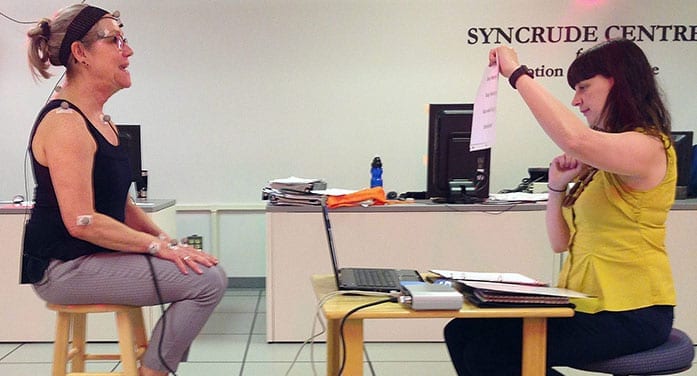Hand gestures or tone of voice can give an instant impression about someone, and, for transgender women, that can be especially important.
“Living in the society we live in, there are gender expectations for what a feminine communicator sounds like or looks like,” said Teresa Hardy, an instructor in the University of Alberta’s Faculty of Rehabilitation Medicine. As a speech-language pathologist, Hardy also works with transgender clients, many of whom want to have a feminine voice.
It’s a keenly felt quality of life issue, said Hardy, who led a recent study to explore the satisfaction levels of transgender women with their gestures and voice characteristics.
“Our clients don’t want to be misgendered by other people, and we want to help them find a voice that better represents them, that they feel more comfortable with and that they can feel confident using,” Hardy said. “In some cases, if they aren’t being read as transgender in the community, they may feel safer. Many also feel a sense of validation in people seeing them for who they are, and voice can contribute to that.”
The study, which involved 20 transgender women volunteers, measured several aspects of their communication, including hand gestures, voice pitch, intonation and head movements, among others, while they told a story. It also had the participants rate their own communication in terms of femininity and their level of satisfaction with it, and their quality of life.

Teresa Hardy (right) and study co-author Carol Boliek practise collecting data for their study, which involved measuring several aspects of verbal and non-verbal communication among transgender women volunteers as they told a story. (Photo: Supplied)
The measures were then analyzed, revealing that the study subjects were more satisfied with their overall communication when they used hand gestures with the palm facing down when they were talking. The research also indicated that if they rated their quality of life higher, they had more lively intonation patterns.
Along with other research, the findings help build a better understanding of what factors in voice and gestures may be related to training outcomes for clients, Hardy said.
“As we learn more about those relationships, we may be able to identify the training targets that are most meaningful for our clients or that help them to better achieve their goals.
“It’s a relatively new area of practice for speech-language pathologists, and now we have insight into what aspects of voice and communication are more important to transgender women,” she said, noting that this is among the first research to ask the clients about their perceptions of communication.
“This study focused on the speaker rather than the listener; it’s important for us to understand the client’s perspective, rather than relying on gender norms and cultural stereotypes.”
The study is the latest in a suite of research by Hardy, who holds a PhD in Rehabilitation Science from the U of A, and her colleagues.
Hardy, who practises at the Glenrose Rehabilitation Hospital, also helped lead the first studies to objectively measure gestures among transgender women. “There have been qualitative studies in the past that have talked about non-verbal communication but haven’t measured it.”
The work explored what aspects of communication cue others about a person’s gender, including verbal and non-verbal parameters such as voice pitch, tone quality of voice, intonation, loudness, and head and hand movements.
The research is also important for recognizing diversity, Hardy added.
“There’s no one way to be a feminine or masculine communicator; we shouldn’t rely on gender biases. We should appreciate and celebrate the differences between groups of people, and within those groups, differences between individuals, their different perspectives and the diversity in communication.”
Hardy’s research was funded by a Social Sciences and Humanities Research Council (SSHRC) doctoral fellowship and Alberta Innovates, with in-kind support from the Syncrude Centre for Motion and Balance at the Glenrose Rehabilitation Hospital.
| By Bev Betkowski
This article was submitted by the University of Alberta’s Folio online magazine. The University of Alberta is a Troy Media Editorial Content Provider Partner.
© Troy Media
Troy Media is an editorial content provider to media outlets and its own hosted community news outlets across Canada.


